
Iron Horizon
Iron Horizon is an action adventure game existing in a dystopian future where giant flying dreadnoughts own the skies. Using the limited resources to control the population, these fear mongers need to fall. That's where you come in. Guided by the dreadnoughts original creator, and wielding a devastatingly powerful pair of chainsaw wings, it's up to you to tear apart these sky fortresses from the inside out.
Iron Horizon was a finalist in 'The Rookies' 2019 competition for best game.
A more full overview of this project can be found here.
Trailer
Gameplay
Iron Horizon is a brutal new approach to action shooters. While the player still has traditional weapons, they can only use those picked up from the enemies they've slain. They can also activate a deadly chainsaw spin attack from the skies, tearing apart anything in their path. They are loaded with destructive force, and can tear apart the ship from within, ultimately bringing it crashing down from the skies.
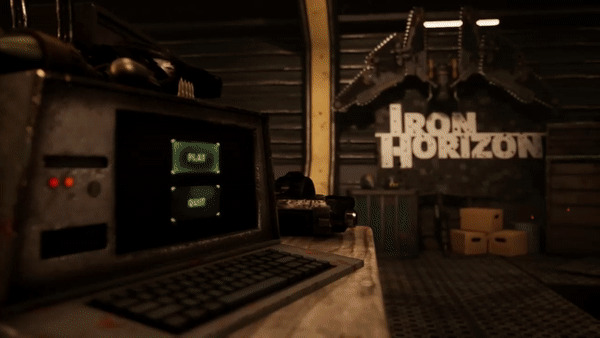
The Mechanics
Player Movement
The player has two distinct modes of movement. On the ground, they move very standard. They can, however, take to the skies by toggling open their wing pack after either jumping, or expending a bit of fuel to go into a hover mode. When flying, they have glider like movement, gaining speed by nosediving down and losing it by flying up. They can wall grab and kick off to quickly turn themselves around, but can also retract their wing pack, and reopen it to change orientation and build up a bit of speed.


Chainsaw Wing Attack
The players most powerful attack comes from their chainsaw wings. They are armed with a glider lined with sharp teeth. If the player has the diesel required, they can activate their thruster, make those teeth spin, and tear through anything standing in their destructive path. Activating their wings can also give them a boost of speed, and increase their maneuverability, allowing them to jet out of a dangerous situation.
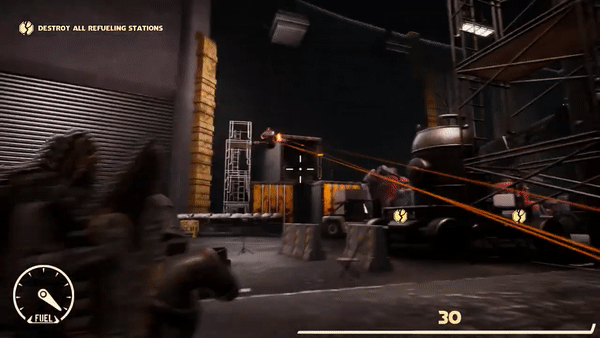
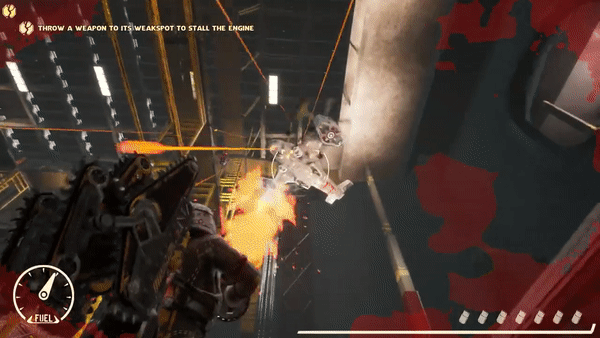
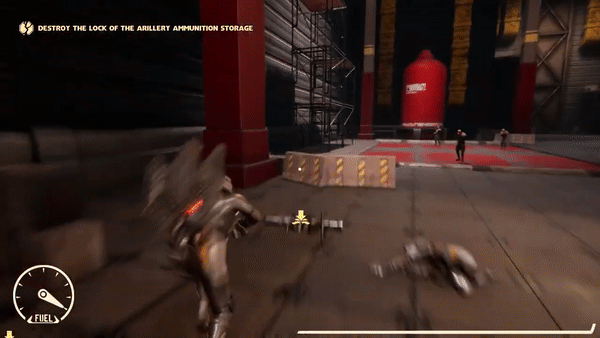
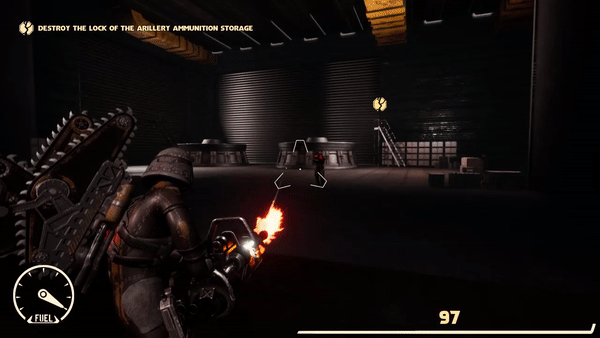
Guns!
There are four guns that can retrieved within the dreadnought. Each comes with its own strengths and setbacks that promote interesting game play scenarios. Once weapons are empty, they can't be reloaded, but they can be thrown at enemies for a but of explosive damage.
Shotgun= The most common weapon scattered throughout the ship. This gun is powerful, but ineffective past medium range. It scatters twelve buck shots at enemies.
Assault Rifle= This gun is accurate, but has the lowest damage profile of all the weapons. It fires 30 shots at a semi-rapid pace and is good to pick off enemies that prefer close range, or to make more pinpoint accurate shots at their weak points.
Rocket Launcher= A heavy weapon, the Rocket launcher fires a devastating rocket that explodes on impact. It's capable of eliminating groups of enemies, or deal massive damage to a heftier target. While accurate at first, the rocket will began to trail off after a bit of flight time.
Chain Gun= This gun is a large, powerful weapon but is scarcely found within the ship, usually needing to be retrieved from fallen gunships. It fires 100 shots rapidly, and can tear through groups of enemies handily.
Destruction
The ship has many different objects within it that can be destroyed. All of the destructibles have a yellow coloration to make it visually apparent to the player what can or cannot be torn apart. A few of the destructables can eliminate opponents if they are standing on top of them, or if they fall onto them.
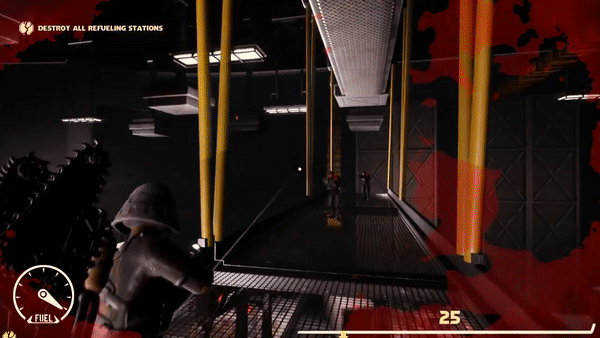
Siphon and Fuel
The ship has diesel fuel tanks scattered throughout it. To take advantage of this, the player comes equipped with a siphon that can drain the fuel out of them. They can use this diesel to active their most powerful and deadly attack, the chainsaw wing spin. The attack also helps with maneuverability, which is needed to escape some of the more dangerous game play scenarios.
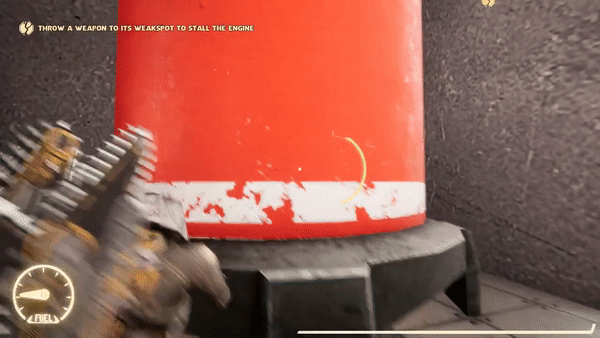




Enemies
There are four enemies types within the dreadnought. Each enemy serves to create a unique game play scenario for the player, and when combined, promote meaningful choices for the player. They are modular, and fire can be targeted at specific parts of them to bring them down in different ways. They are given very distinct silhouettes as to stand out from one another at a single glance.
Ground Infantry= These are the most prevalent enemies. They can be armed with the shotgun or assault rifle. They will roam the ship's floors and try to eliminate you if seen.
Flying Infantry= The second most prevalent enemy, these enemies wield the assault rifle. Flying throughout the ship, they can be harder to pin down unless you can use your glider to position yourself higher or you've collected the resources for a chainsaw wing attack.
Rotocraft= The rotocraft is stronger than the standard ground and flying infantry, and packs more fire power too. It sticks to the skies, trying to shoot the player down with its machine gun hail of bullets. Hit the exposed pilot or fuel tanks and send it crashing easily.
Gunship= Armed to the teeth, these powerful monsters are hard to destroy. They have a quick firing machine gun and can launch explosive rockets. Target your fire at a specific part of it, destroy its fuel tank, or snipe the pilot in the cockpit to bring it down in a ball of flames.
Full Gameplay Video
Role and Development
Iron Horizon was developed as our senior project using the Agile system, and was completed in 20 weeks on May 29th, 2019. On this project I acted as the lead game designer, a systems designer, and associate producer. I was responsible for overseeing the games design to make sure it stayed integral to it's initial spirit while also evolving to be 'fun', all while and managing the team of five designers. As a systems designer I created all the weapons, implemented animations, created all the systems for menus and UI, and created the destructables. As the associate producer, I was in charge of helping the project lead to organize all our files, create documentation, set up group meetings, help to gauge and raise group morale, and guide the game in the right direction.

Obstacles and Challenges
Iron Horizon was the largest project I worked on to date. Because of this, I had my first taste of what working on a real development team creating a sizable product would be like. We had to learn Agile, keep up with scrum, and stay motivated and organized. There were points where we failed at all of these things, but we were able to recover and finish development of Iron Horizon. Because of the team size, everyone had different issues and needed individualized solutions, something I tried my hardest to provide.

Inspiration
Iron Horizon went through tons of iterations. We loved the idea of tearing down a sky fortress, and tried to design around this idea. At points, we faltered from this, but were able to recover and stay true to that initial idea. We created a badass with chainsaw wings that tears down an unkillable fortress in the clouds.

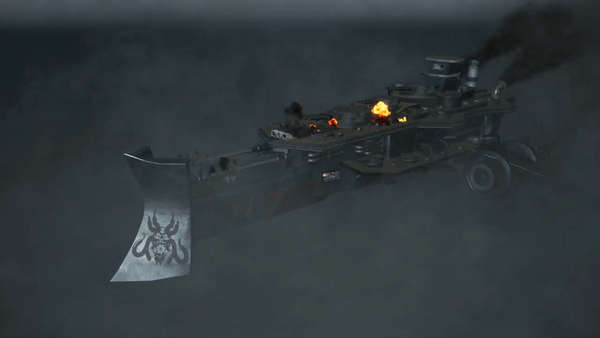
What I Learned
Iron Horizon is the largest product I've worked on to date. Through it, I learned invaluable lessons about the development process. In addition to learning the Agile development system, I discovered a lot about iterative design. After ten weeks, our team produced a product that we were not quite content with. The learning curve was steep. After dozens of meetings, we ended up with a redesigned product – one which reflects our team's initial vision. We were able to capture the soul of our initial ideas while applying new knowledge and techniques resulting in a game we were all proud of. As the lead designer, my main task was to serve in a leadership role. Our team had great ideas but needed support, structure, and a plan to maximize its creative talent and produce a cohesive product. This included having all ideas flow through me, as the leader, to ensure continuity and unification of our project. As a team leader, I encouraged sharing of all ideas and considered them equally. The team then worked together to analyze and decide on which ideas best fit our end goal. Implementation of this leadership helped create a unified product with equal collaboration from all team members. Learning how to transition into a leadership role to provide constructive feedback and a platform for the entire team proved to be the most valuable lesson I learned.
As the Associate Producer, this was the first project where I was not in a lead role. This taught me to become a team player - providing any support needed under the group's leadership. This included document organization, freelance assistance, meeting coordination, monitoring of the team's morale and structuring the most efficient team possible. Ultimately, I settled into my new role as an Associate Producer realizing my support was integral to the overall production of the project.
Contributors
Simon Lauer= Project lead, VSFX, and Game Design
Parker Daniels= Lead Artist and Environmental Artist
Leo Lo= Lead Systems Design and Game Design
Jonathan Rey-Brookes= Game and Systems Design
Alex Sanches= Level Design, Prop and Environment Artist
Drew Dicenso= Tech Support, Prop and Environment Artist
Justin Graber= Character and Enemy Artist
Tianyi Liu= Concept Artist
Additional Freelance Artists:
Benton Pellet: Sound Designer
Antonio Muniz: Animator
Dia Hadley: Animator
Aaron Stedman: Animator
Justin Yong: Character Rigging















